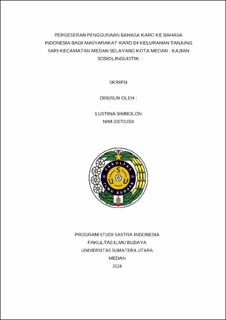Pergeseran Penggunaan Bahasa Karo ke Bahasa Indonesia bagi Masyarakat Karo di Kelurahan Tanjung Sari Kecamatan Medan Selayang Kota Medan : Kajian Sosiolinguistik
The Shift of The Use of The Karo Language to Indonesian for The Karo Community in Tanjung District Sari Medan District Selayang Medan City: Sociolinguistic Study

Date
2024Author
Simbolon, Lustina
Advisor(s)
Sembiring, Sugihana
Ritonga, Parlaungan
Metadata
Show full item recordAbstract
Sociolinguistics is an interdisciplinary science between sociology and linguistics that takes language as its object of study and its relationship to the use of that language in society. This research highlights the phenomenon of the shift in the use of Karo language to Indonesian for the Karo community, especially among a group of children who live in Tanjung Sari Village, Medan Selayang District, Medan City. This research aims to describe the process of shifting language use and the factors driving this shift in language use. This research is a type of qualitative descriptive research. The data source for this research is in the form of conversation fragments from interviews with informants, namely 10 children from the Karo language speaking community, consisting of 5 men and 5 women aged 15-25 years. The data collection techniques used were observation/observation and conversation (interviews) using fishing techniques, face-to-face techniques and recording and note-taking techniques. Data were analyzed using theory with a sociolinguistic approach by Chaer (2010) regarding the language shift process and Sumarsono (2002) regarding the factors driving language shift. The results of this research indicate that there is a process of shifting the use of Karo language into Indonesian among second generation children from the Karo language speaking community in Tanjung Sari Village, Medan Selayang District, Medan City in accordance with the pattern proposed by Fishman (Chaer, 2010), namely the bilingual pattern. subordinate (B1>B2), equivalent bilingual (B1=B2) and subordinate bilingual (B2>B1). Of the 10 informants, 2 experienced a subordinate bilingual process (B1>B2), 3 experienced an equivalent bilingual process (B1=B2) and 5 experienced a subordinate bilingual process (B2>B1) and were driven by migration factors, economic and social factors as well as school and education factors.
Collections
- Undergraduate Theses [617]
